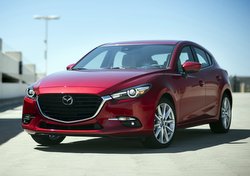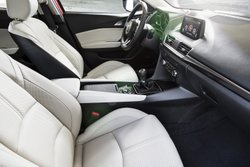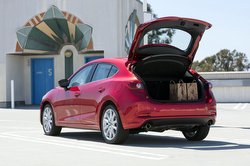Handy, Handsome, and a Hoot to Drive
Mazda has decades of history in the U.S., but is probably best known for its iconic Miata (or MX-5, as it’s officially branded today). With sporty handling and more than a million sold, it embodies the spirit of the brand. Mazda’s bestseller here, the Mazda3 (five million sold since 2004), has some of the Miata’s look and feel. Those qualities separate it from the mundane grocery-getters in the compact segment.

With a recent redesign, the 2017 Mazda3 Five-Door receives only minimal tweaks to refine its styling, improve interior quietness and simplify model nomenclature. You have the Sport and Touring, which use a 2.0-liter four-cylinder engine that puts out 155 horsepower (hp) and 150 pounds-feet (lb.ft.) of torque. Step up to the Touring 2.5 and Grand Touring and you’ll get the more potent 2.5-liter engine with 185 hp and 184 lb.-ft. of torque.
This latter engine moves the 3,046-pound Mazda3 along, especially with the manual six-speed transmission, available in some models, including my top-level Grand Touring test car. Although rowing through gears is as odd as making calls from your rotary-dial home telephone (in beige, almond, white, or black), there’s more here than nostalgia. Engagement with the car is significantly greater when you’re responsible for shifting.
Positioning is Everything
To make it more fun, Mazda positions the tachometer right in the center of the instrument panel, with a small digital speedometer tucked inside it. That’s part of how the Miata qualities percolate into the larger Mazda3 people-hauler.

The EPA awards the 2017 Mazda3 Five-Door with 2.5-liter engine and six-speed manual ratings of 25 city/33 highway/28 combined. I averaged 27.5 mpg during my test week. Green scores are twin 6’s for Smog and Greenhouse Gas.
One new feature for 2017 is standard G-Vectoring Control technology. It uses engine timing to control chassis dynamics for smoother, more accurate steering inputs. You may not know it’s there, but it helps you drive the car better while keeping you safer.
Mazda makes a good point when they say that with the many performance and comfort/convenience features the Mazda3 provides, why bother looking at other, often much pricier, models? In the Grand Touring, that’s a good argument. My Eternal Blue Mica tester featured a sharp-looking black and white interior that kept the accommodations serious, but also a bit festive. The sporty seats are comfortable too—eliciting approval from my wife, who rides in every car and only speaks up about something if she really likes it or strongly disapproves. These seats got two thumbs up from her.
First, Figure Out Where Everything Is
The driving experience is easy once you learn where everything is located. A little flip-up panel on the dashtop enables a head-up view of speed–and local speed limit–at a glance. The driver controls climate, entertainment and other apps from the center console dial—a nod to Audi and BMW. Buttons surrounding the dial guide you to the locations you need and then you can turn and push to select what you want.

The Mazda3 comes as a four-door sedan or a five-door hatchback. My tester, in five-door form, proved how handy compact hatchbacks and wagons can be. I hauled musical gear with ease and, frankly, the two models look a lot more alike than they used to in earlier days. The Kodo design scheme blends sharp edges into softer forms, creating the look of motion while imparting a feel of solidity.
Like most vehicle lines, the Mazda3 offers you choices, not only in color, body shape and trim level, but with option packages. My Grand Touring included two—the Premium Equipment Package ($1,600) and i-Activesense Safety Package ($1,100). The first brightens up the night with Bi-LED headlamps with auto-leveling as well as pivoting adaptive front-lighting. More illumination comes from LED daytime running lights. The steering wheel gets heat and paddle shifters (in the automatic). Lastly, a navigation system and auto-dimming feature round out the package.
i-Activesense is a bundle of safety tech, including high beam control, lane departure warning, lane keep assist, radar cruise control, smart brake support and the interesting traffic sign recognition. All these, by the way, are steps towards the self-driving car—but you can’t do that with the Mazda3 yet.
Summary

The least expensive Mazda3 is the four-door sedan, but in five-doors, it starts with the Sport with manual six-speed, at $19,970, and tops out at $25,820 for the Grand Touring with automatic. My tester, with the two packages, came to $27,730.
Cars in the $28,000 range, especially equipped like my tester, are on the lower end of the car market these days. With its performance features and handsome styling inside and out, you may want to ignore those fancy BMWs and Mercedes-Benzes. Get a 2017 Mazda3 Five-Door, and pocket the difference. This award-winning compact is a buff magazine favorite. With its Miata genetics, it’s good for plenty of “zoom-zoom.”
In order to give you, the reader, the best perspective on the many vehicles available, Clean Fleet Report has a variety of contributors. When possible, we will offer you multiple perspectives on a given vehicle. This comes under SRO-Second Road Test Opinion. We hope you’ll enjoy these diverse views–and let us know if you do or don’t at publisher@cleanfleetreport.com.
Related Stories You Might Ejoy:
Road Test: 2017 Mazda3 (Larry’s View)
Road Test: 2017 Mazda3 (John’s View)
Road Test: 2017 Mazda CX-3
Road Test: 2017 Toyota Corolla
Road Test: 2016 Honda Civic
Road Test: 2016 Ford Focus Electric
First Drive: 2016 Nissan Sentra
Road Test: 2017 Volkswagen Golf TSI
First Drive: 2017 Volkswagen e-Golf
Disclosure:
Clean Fleet Report is loaned free test vehicles from automakers to evaluate, typically for a week at a time. Our road tests are based on this one-week drive of a new vehicle. Because of this we don’t address issues such as long-term reliability or total cost of ownership. In addition we are often invited to manufacturer events highlighting new vehicles or technology. As part of these events we may be offered free transportation, lodging or meals. We do our best to present our unvarnished evaluations of vehicles and news irrespective of these inducements.
Our focus is on vehicles that offer the best fuel economy in their class, which leads us to emphasize electric cars, plug-in hybrids, hybrids and diesels. We also feature those efficient gas-powered vehicles that are among the top mpg vehicles in their class. In addition, we aim to offer reviews and news on advanced technology and the alternative fuel vehicle market. We welcome any feedback from vehicle owners and are dedicated to providing a forum for alternative viewpoints. Please let us know your views at publisher@cleanfleetreport.com.

11 thoughts on “Road Test: 2017 Mazda3 Five-Door”